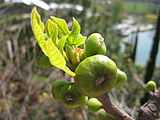Parable of the barren fig tree

The Parable of the Barren Fig Tree (not to be confused with the parable of the budding fig tree) is a parable of Jesus which appears in one of the Canonical gospels of the New Testament. According to Luke 13:6-9 the parable is about a fig tree which does not produce fruit.
Narrative
The parable is as follows:
He spoke also of this parable; A certain man had a fig tree planted in his vineyard; and he came and sought fruit thereon, and found none. Then said he unto the dresser of his vineyard, Behold, these three years I come seeking fruit on this fig tree, and find none: cut it down; why cumbereth it the ground? And he answering said unto him, Lord, let it alone this year also, till I shall dig about it, and dung it: And if it bear fruit, well: and if not, then after that thou shalt cut it down.— Luke 13:6–9, King James Version
Interpretation
In this parable, the owner is generally regarded as representing God, who had a fig tree (tree of knowledge) planted in his vineyard (the garden of Eden) and came seeking fruit (righteous works, which in part is a mystery). The gardener (vinedresser) is God and the vine is Jesus (tree of Life).[1] Fig trees were often planted in vineyards.[2]
The fig tree was a common symbol for Israel, and may also have that meaning here,[1] or the tree in the parable may refer to the religious leadership.[2] In either case, the parable reflects Jesus offering his hearers one last chance for repentance.[2] "These three years" logically refers to the period of Jesus' ministry. The parable has been connected to the miracle of cursing the fig tree. Richard Whately commented that this parable "is one which our Lord may be said to have put before his hearers twice; once in words, once in action."<ref name="RW>Richard Whately, Lectures on Some of the Scripture Parables, John W. Parker and Son, 1859, p. 153.</ref>

Authenticity
Although the parable is found only in Luke's gospel, there is no strong argument against authenticity, even a majority of the members of the Jesus Seminar voted it authentic.[2]
Parallel in Matthew and Mark
The Cursing the fig tree appears as an episode in the life of Jesus rather than as a parable, but it has very similar wording as the Parable of the Barren Fig Tree.
See also
References
- ↑ 1.0 1.1 Timothy Maurice Pianzin, Parables of Jesus: In the Light of Its Historical, Geographical & Socio-Cultural Setting, Tate Publishing, 2008, ISBN 1-60247-923-2, pp. 235-237.
- ↑ 2.0 2.1 2.2 2.3 Peter Rhea Jones, Studying the Parables of Jesus, Smyth & Helwys, 1999, ISBN 1-57312-167-3, pp. 123-133.
| Wikimedia Commons has media related to Parable of the Fig Tree. |
| ||||||||||||||||||||||||||||||
